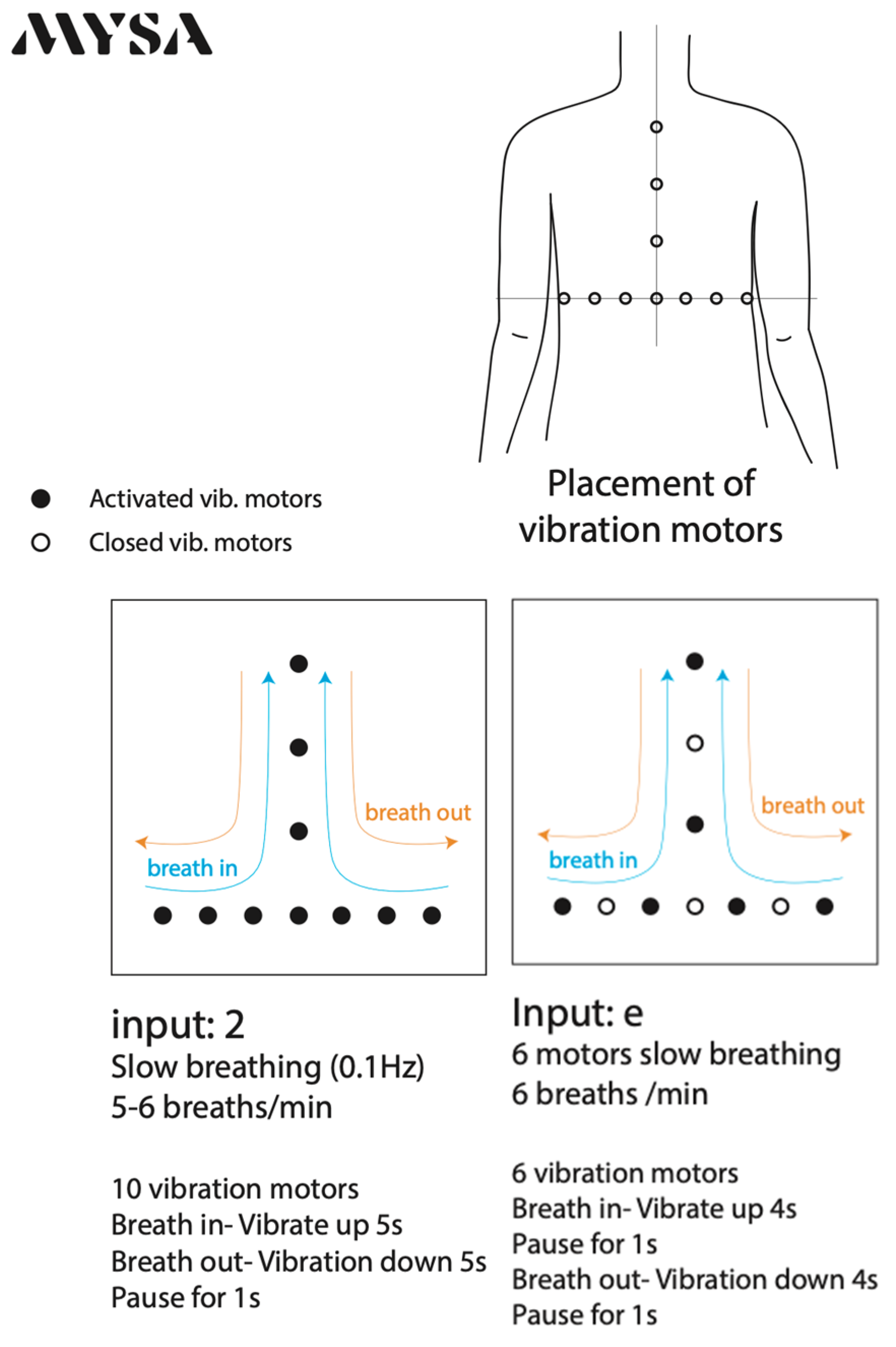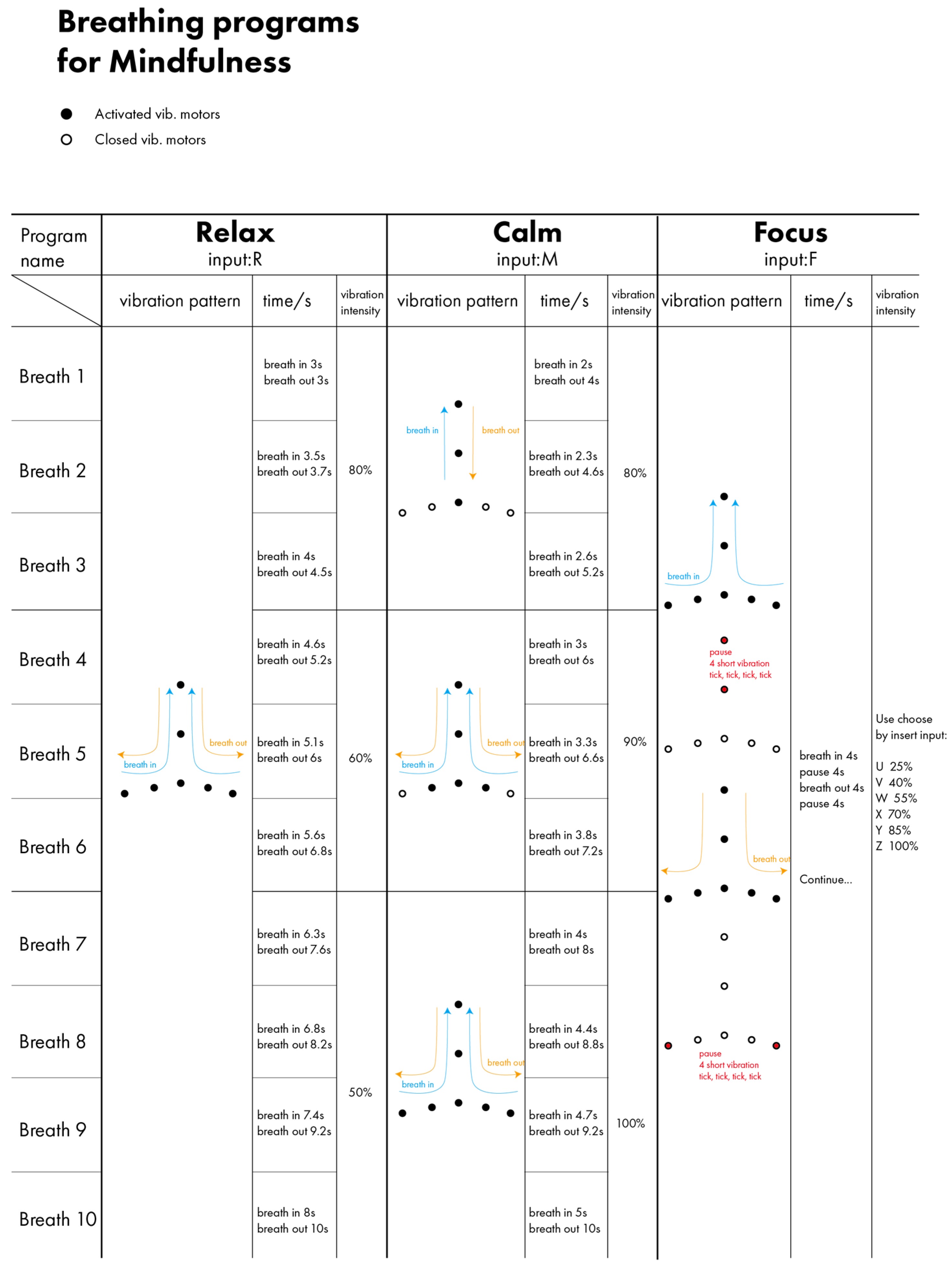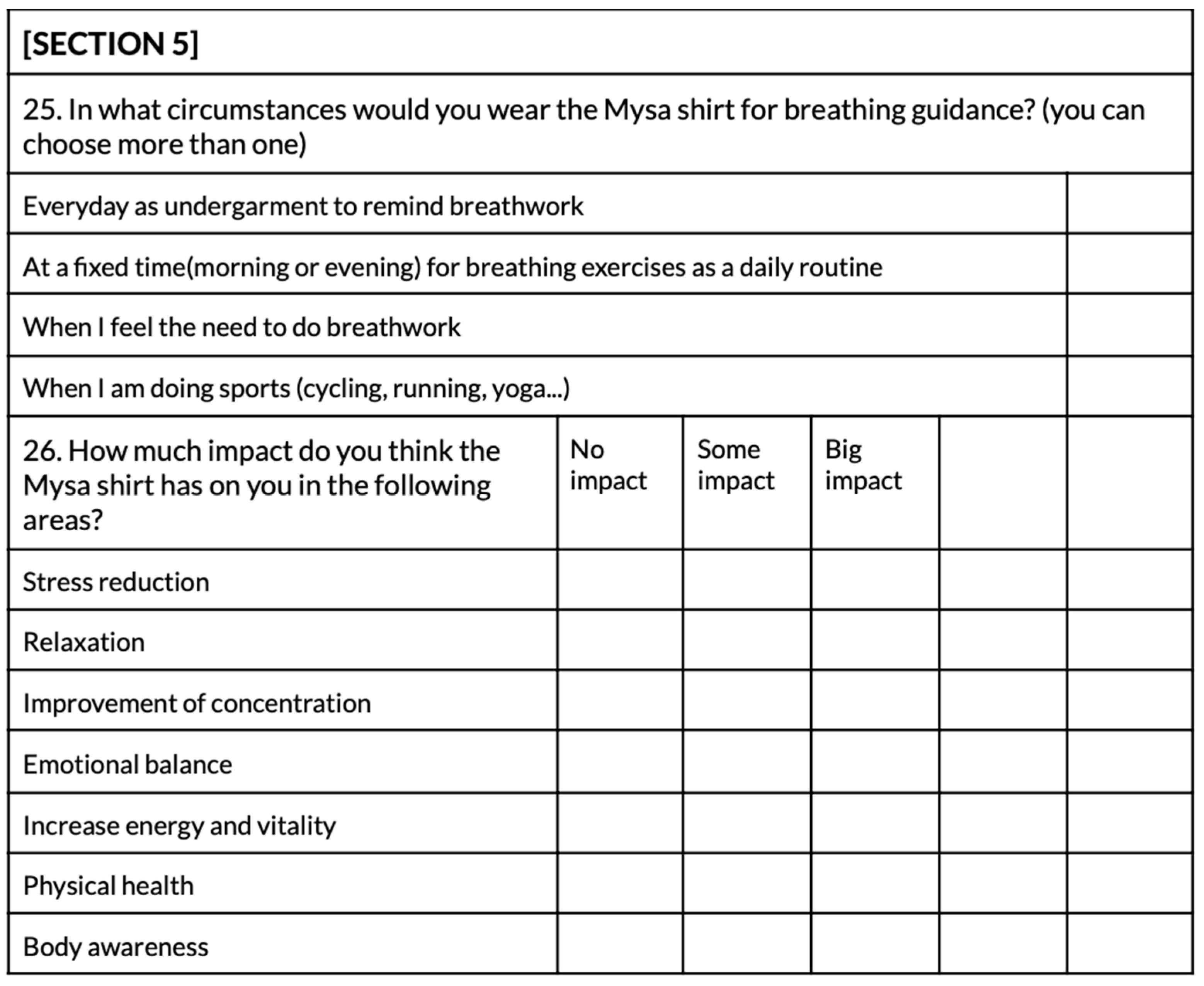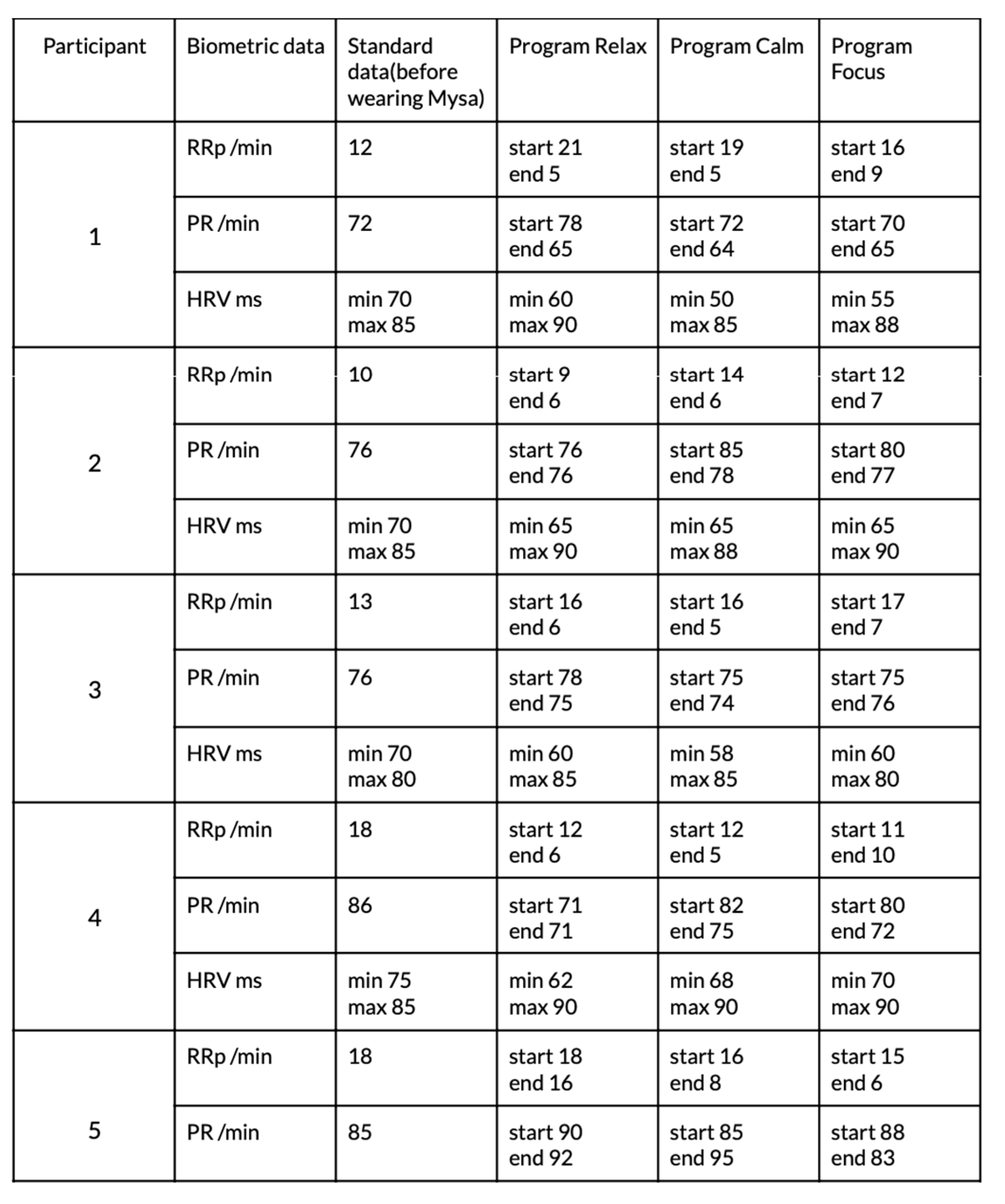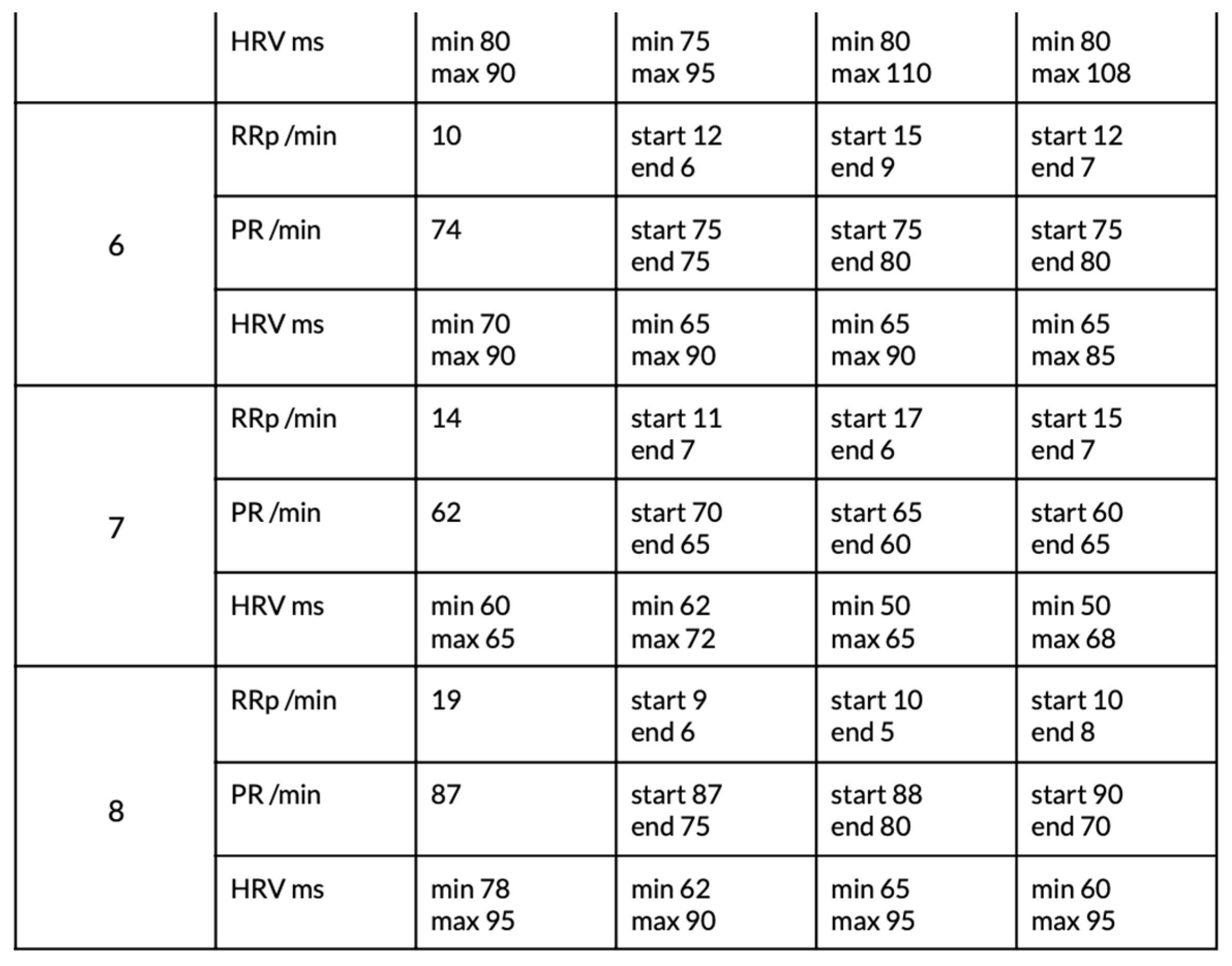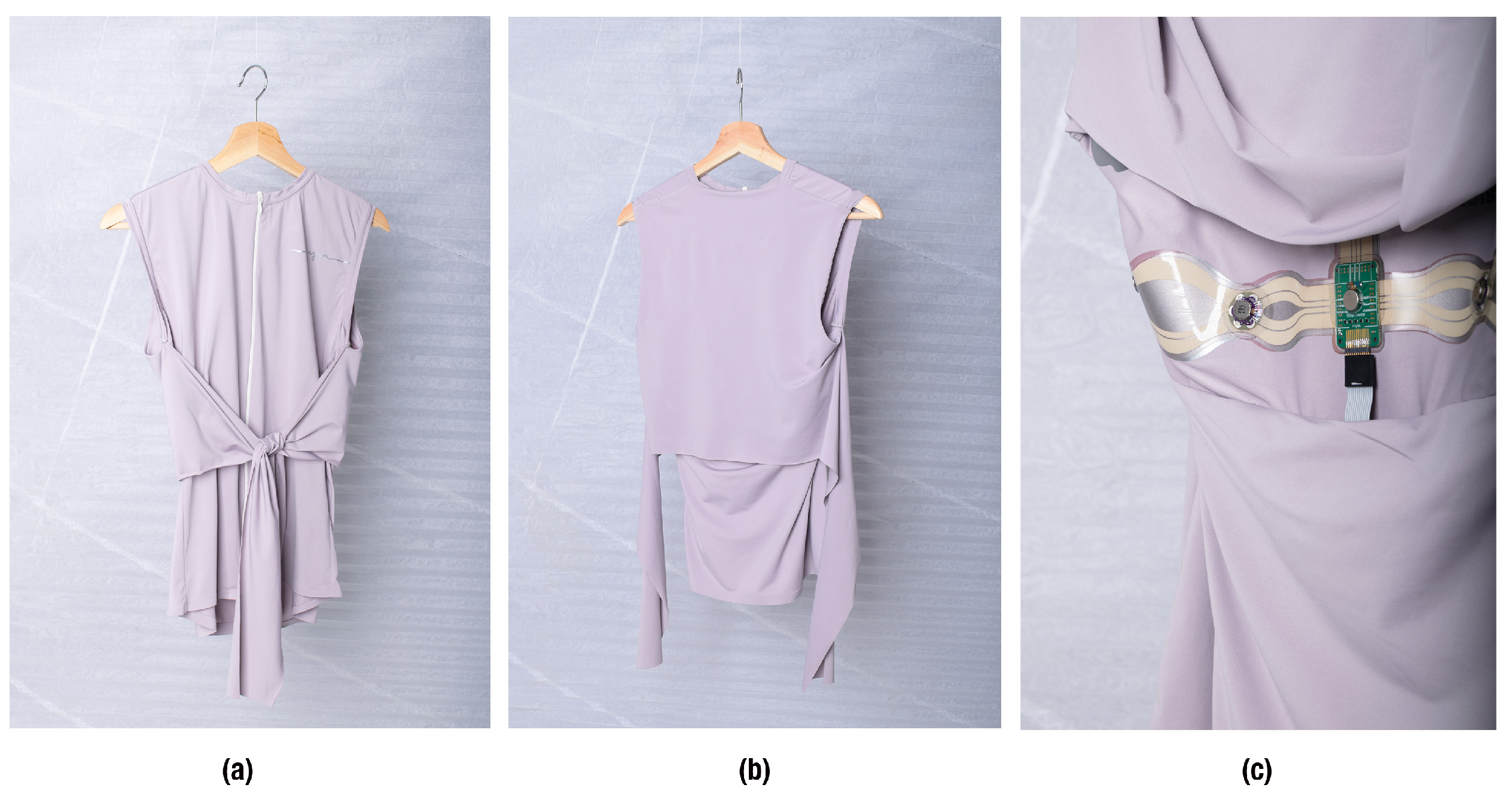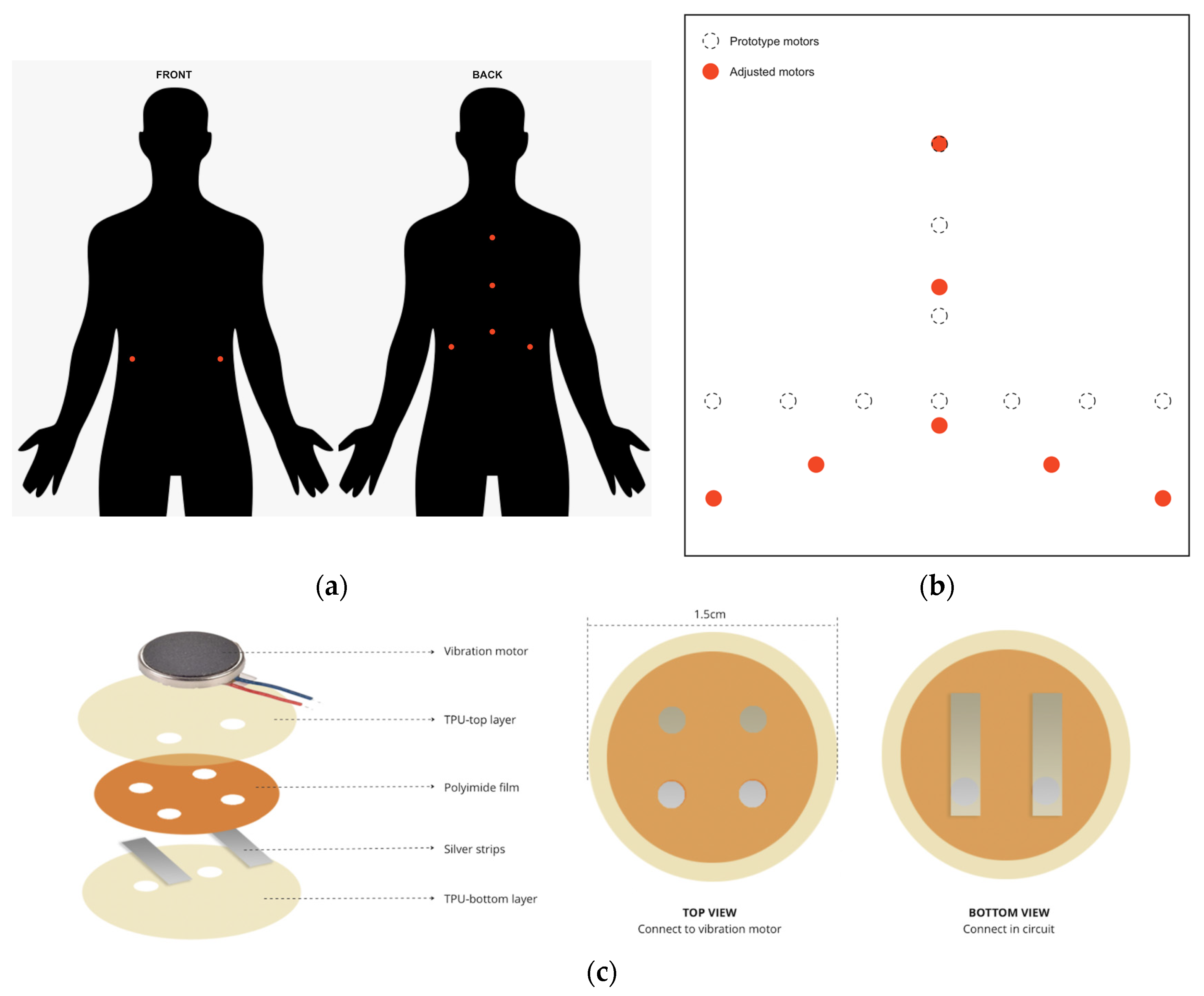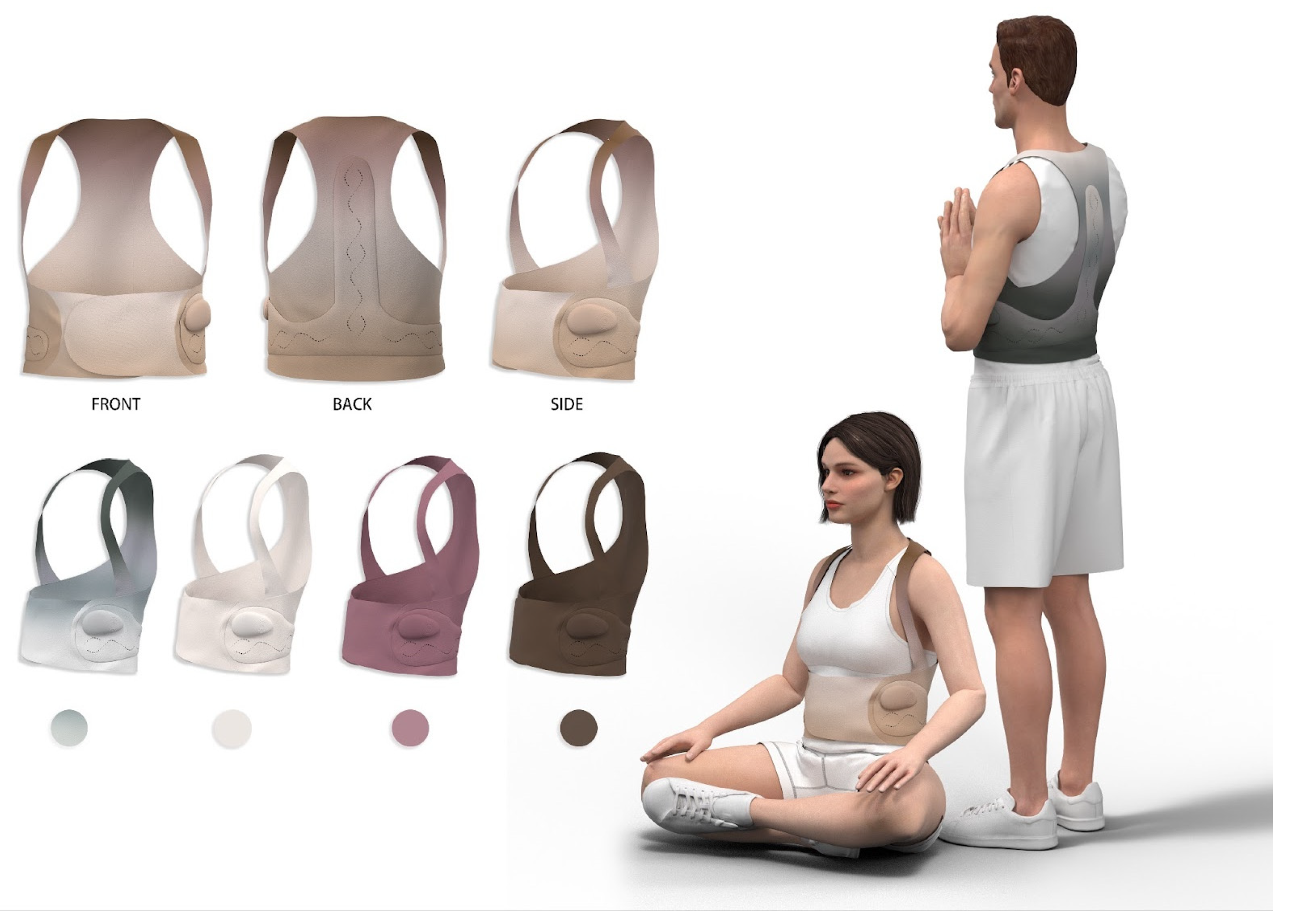1. Introduction
Mindfulness has gained immense popularity in recent years [
1] as more individuals, especially the younger generation [
2], seek ways to release stress and improve their overall well-being. With the accessibility of online resources, a growing number of people turn to mindfulness practice through digital platforms [
3]. In general, the existing guided or assisted mindfulness or meditation products or services are primarily designed around three sensory layers: auditory (language, music, and environmental noise), visual (static, dynamic, and VR), and occasionally tactile (vibration).
However, these resources often fall short in providing interactive and effective guidance to assist and enhance mindfulness experiences, which leads to user’s superficial engagement and quick abandon. Research indicated that mindfulness-based applications are less effective because there is a lack of diversity in the techniques, as well as in the context they are employed [
4]. The design implications section of the article emphasizes that “the body plays an important role in mindfulness meditation by being the object of attention...we can think of new design opportunities such as novel tangible interfaces for supporting bodily aspects”.
Clothing holds the potential to become a powerful medium of interaction, as it is in constant contact with the body and skin. Previous studies already proved that tactile feedback contributes to increasing body awareness [
5], and haptic stimulation such as vibration and pressure can promote calmness and reduce anxiety [
6].
The Mysa shirt [
7], designed and developed by newly founded start-up Touchwaves BV, is a smart shirt that can assist with breathwork through haptic technology. The Mysa shirt prototype (
Figure 1) is made of recycled polyester textile, integrating a stretchable printed circuit and 10 vibration motors to provide guidance on various breathing exercises. This technology, offering full-body sensorial stimuli, has the potential to be redesigned to specifically support the practice of mindfulness and enable more immersive and effective conscious breathing.
2. Methodology
This research centers on testing the Mysa shirt to gather user feedback, enhancing product design and user experience, particularly targeting mindfulness practitioners, both novice and expert ones. This study follows a user-centered design (UCD) approach, through semi-structured interviews with both experienced mindfulness experts and novices, leading to the redesign of the Mysa shirt prototype tailored to user needs. The prototype with newly designed breathing programs has been further tested to assess its efficacy and performance.
2.1. Semi-Structured Interviews
The semi-structured interview approach utilized the snowball sampling method to search for interviewees from mindfulness meditation schools and ArtEZ University. The sample consisted of four mindfulness meditation teachers and four beginners. They were all based in The Netherlands, 12.5% were men and 87.5% were women, with ages ranging from 35 to 55. The interviews were conducted one-on-one with each individual, lasting approximately half an hour. The objective of the interview was to explore their mindfulness experiences, practice behavior, difficulties, needs in the practice, and pain points to guide the design practice in the next research steps.
2.2. 1st User Test: Mysa Prototype Wearing Test
A voluntary sampling method was used to recruit 29 participants who had at least one experience with mindfulness, meditation, or breathwork. The average age of participants was 38, ranging from 20 to 50 years. The gender distribution included 56% females and 44% males. All participants were residents in The Netherlands and engaged in various professions. Each participant was invited to wear a Mysa shirt for a duration of 10 minutes, breathing and following the vibration guidance of Mysa (
Appendix A). After the wearing experience, their feedback was gathered through a short one-to-one interview.
2.3. Redesign of the Mysa Prototype
Based on user interviews and consultation with mindfulness experts, the redesign of the Mysa prototype focused on three aspects: circuitry redesign, breathing program redesign, and garment redesign.
The circuitry redesign proposed to reduce the quantity and change the placement of the vibration motors, aiming to optimize the haptic sensation and reduce material use.
Figure 2 shows the new arrangement of the vibration motors and the redesigned motor module build-up.
The new breathing programs—Relax, Calm, and Focus (
Appendix B)—were designed to intuitively guide users in achieving different mindfulness meditation goals through varying vibration frequency, speed, and patterns. These programs are a result of insights gleaned from interviews, guidance from mindfulness teachers and practitioners, and user feedback from the first test. Their effectiveness has been validated through the second user test in
Section 2.4.
The redesign process of the Mysa shirt entailed considerations of aesthetics, functionality, and suitability across diverse body sizes and genders.
Figure 3 presents a versatile, unisex vest designed to optimize vibration feedback for the user. This design allows for both innerwear and outerwear, seamlessly complementing the user’s existing wardrobe. The vest is easily removable, facilitated by the Velcro design on the waistband, and its compact, portable nature enhances convenience.
2.4. Second User Test: Newly Designed Breathing Programs Test
Eight participants were recruited through snowball and voluntary sampling, comprising 75% novice (0–5 years of experience) and 25% professional (10+ years of experience) mindfulness practitioners. Among them, 86.7% were women and 13.3% were men, ranging in age from 20 to 55, and all residents in The Netherlands. The participants were interested in breathwork and had experienced mindfulness or meditation at least once.
Participants were instructed to wear the Mysa shirt and evaluate the three newly designed mindfulness breathing programs. The testing process included both a qualitative self-assessment questionnaire (
Appendix C) and a quantitative test involving wearing Mysa while monitoring real-time respiration rate (RRp), pulse rate (PR), and heart rate variability (HRV) data through two extra wearable devices: a pulse oximeter [
8] and an HRV ear clip [
9]. The values of the parameters were recorded both before and after each breathing program.
3. Results
3.1. Semi-Structured Interviews Results
Teachers admitted that breathwork is a crucial element for practicing mindfulness. Challenges faced by beginners, such as discomfort and distraction, underscored the need for proper guidance and specialized workshops. Regarding mindfulness apps, while they found them average, they recognized the potential benefits for beginners. Mysa’s introduction sparked curiosity among teachers, with one suggesting its potential for aiding attention deficits and another noting its potential benefit for beginners lacking awareness.
The mindfulness beginners were interested in the Mysa shirt because of their need to manage work and study-related stress. They are found to practice less frequently (1–3 times per week for 10–20 min), often supported by tools like guided audio and smartwatches. Beginners faced challenges such as distraction and lack of body awareness, mitigated through external aids like timers and mindfulness apps. Feedback on the Mysa shirt during a mindfulness breathing session was positive, noting enhanced awareness but also expressing concerns about its limitations, primarily for back-focused vibrations and confusion about intensity levels and the overall fit of the garment.
3.2. User Test Results
The first user test, based on wearing the Mysa shirt and assessing their feedback, resulted in relatively positive outcomes. Nonetheless, several areas require improvement, including designing more inclusive clothing, achieving better-fit tailoring, adjusting the position of the vibration motors and hardware, and enhancing the overall user experience to be more user-friendly. Particularly, for mindfulness practitioners, developing a breathing program better suited to adapt to slow breathing during mindfulness activities was considered essential.
The results of the second user test were focused on assessing the effectiveness of three breathing programs in reducing RRp, promoting relaxation, and analyzing changes in PR and HRV during the Mysa wearing test. Detailed biological data from eight participants are presented in
Appendix D. The RRp had a gradual reduction during the tests, and remained around 6 RRp/min, indicating an effective transition from rapid to slow breathing. PR data showed little change across programs, indicating that breathing programs might not directly influence PR. During the tests, average HRV variations increased substantially (26.37 ms, 27.12 ms, and 24.87 ms). Participants with a higher baseline of HRVs exhibited larger variations, suggesting a correlation between slower breathing and greater HRV variations. The HRV waveform during breathing programs resembled a regular wave, as depicted in
Figure 4.
In qualitative results, the Relax breathing program was shown to positively influence breathing awareness and relaxation, with 75% acknowledging its efficacy. For the Calm program, 75% expressed a positive experience, and it surpassed Relax and Focus in mental and emotional well-being. The Focus program was found effective in enhancing consciousness and physical well-being, though 25% perceived negative effects on mental and emotional well-being. Overall, participants affirmed Mysa’s positive impact in reducing stress and promoting relaxation.
However, 75% encountered difficulties in understanding the programs based solely on verbal instructions, highlighting the need for longer-duration programs and alternative methods to enhance user experience and utilization of Mysa’s haptic feedback guidance.
3.3. Contribution of UCD in the Design and Implementation of Mysa
The contribution of UCD in the development and implementation of Mysa has been instrumental in shaping an innovative and user-friendly product. UCD principles guided the entire design process, ensuring a thorough understanding of user needs and preferences. Through user interviewing, iterative testing, feedback collection, and continuous refinement, Mysa evolved to address not only functional requirements but also considerations of aesthetics, wearability, and mindfulness experience. The application of UCD methodologies significantly enriched the final product, resulting in a design that seamlessly integrates user insights, making Mysa an intuitive and effective tool for mindfulness practice.
4. Discussion and Conclusions
The haptic-stimulated mindfulness Mysa shirt represents a promising solution for individuals seeking a more immersive mindfulness experience, particularly in the context of stress reduction to achieve overall mental well-being. The paper demonstrated three main findings:
Experienced mindfulness practitioners, while recognizing Mysa’s value as a teaching and learning tool, felt less necessity to use it due to their mastery of practice methods. However, they saw potential in introducing it to students, especially those lacking body awareness and concentration.
Novice mindfulness practitioners expressed positive feedback after using Mysa. They found it effective in enhancing concentration, reducing stress, and promoting a sense of calmness. Participants felt a stronger connection to their mindfulness practice and noted better results compared to commercial online resources and apps that are used to practice mindfulness.
A significant portion (63%) of participants found the vibration guidance method initially confusing, emphasizing the need for clearer usage instructions to understand it better. Additionally, participants suggested designing an interface for customizable breathing programs to cater to individual preferences.
While initial feedback has been positive, the study’s main limitation is the lack of long-term testing and sustained effects. While the current findings present valuable insights, a larger and more diverse sample could enhance the generalizability and reliability of the results. Furthermore, future investigations will need to delve into the exploration of extended test durations, embracing a longitudinal approach to study the phenomenon over a more extended period and consider time frames ranging from a week to a month, or even longer. This approach will enable a more nuanced understanding of the dynamics, accounting for potential fluctuations, trends, and adaptations that may emerge over time.
In addition, the subsequent phases of this research will prioritize the refinement of prototype development and iterations. This step is aimed at fostering the creation of a more mature product for potential market integration. By addressing the limitations and incorporating user feedback, the research aims to optimize the prototype’s functionality, usability, sustainability, and overall effectiveness.
Author Contributions
The study presented in this paper has been conceived by the three authors together, being D.C. and P.v.D. supervisors and reviewers of the work throughout its progression and W.W. the formal executor. In detail, the conceptualization has been defined by W.W., P.v.D. and D.C.; the methodology was structured by D.C.; the software was designed by W.W.; the validation of the study, through data analysis, was performed by W.W. and P.v.D. The resources were provided by P.v.D. and D.C. The paper’s original draft preparation was conducted by W.W. while its final writing, review, and editing were accomplished with D.C. and P.v.D. All authors have read and agreed to the published version of the manuscript.
Funding
This research received no external funding.
Institutional Review Board Statement
Not applicable.
Informed Consent Statement
Informed consent was obtained from all subjects involved in the study.
Data Availability Statement
The original contributions presented in the study are included in the article, further inquiries can be directed to the corresponding author.
Conflicts of Interest
Author Pauline van Dongen was employed by the company Touchwaves. The remaining authors declare that the research was conducted in the absence of any commercial or financial relationships that could be construed as a potential conflict of interest.
Appendix A. Mysa Vibration Guidance for Breathwork
![Engproc 52 00033 g0a1]()
Appendix B. New Designed Breathing Programs for Mindfulness
![Engproc 52 00033 g0a2]()
Appendix C. Self-Assessment Questionnaire for 2nd User Test
![Engproc 52 00033 g0a3a]()
![Engproc 52 00033 g0a3b]()
![Engproc 52 00033 g0a3c]()
Appendix D. 3 Biometric Data from 2nd User Test
![Engproc 52 00033 g0a4a]()
![Engproc 52 00033 g0a4b]()
References
- Clarke, T.C.; Barnes, P.M.; Black, L.I.; Stussman, B.J.; Nahin, R.L. Use of yoga, meditation, and chiropractors among U.S. adults aged 18 and over. NCHS Data Brief. 2018, 325, 1–8. Available online: https://pubmed.ncbi.nlm.nih.gov/30475686 (accessed on 5 December 2023).
- Gray, K. Here’s Why Millennials Are So Dedicated to Practicing Mindfulness. Brit + Co. 2017. Available online: https://www.brit.co/heres-why-millennials-are-so-dedicated-to-practicing-mindfulness/ (accessed on 5 December 2023).
- Misitzis, A. Increased interest for mindfulness online. Int. J. Yoga 2020, 13, 247–249. [Google Scholar] [CrossRef] [PubMed]
- Roquet, C.D.; Sas, C. Evaluating Mindfulness Meditation Apps. In Proceedings of the CHI ’18: CHI Conference on Human Factors in Computing Systems, Montreal, QC, Canada, 21–26 April 2018; pp. 1–6. [Google Scholar] [CrossRef]
- Kim, E.; Heo, J.; Han, J. Attention to breathing in response to vibrational and verbal cues in mindfulness meditation mediated by wearable devices. In Lecture Notes in Computer Science; Springer Science + Business Media: New York, NY, USA, 2021; pp. 415–431. [Google Scholar] [CrossRef]
- Papadopoulou, A.; Berry, J.; Knight, T.; Picard, R.W. Affective Sleeve: Wearable Materials with Haptic Action for Promoting Calmness. In Lecture Notes in Computer Science; Springer Science + Business Media: New York, NY, USA, 2019; pp. 304–319. [Google Scholar] [CrossRef]
- Pauline van Dongen. Mysa—Pauline van Dongen. Pauline Van Dongen. 2019. Available online: https://www.paulinevandongen.nl/portfolio/mysa/ (accessed on 5 September 2023).
- Masimo—MightySat RX. n.d. Available online: https://www.masimo.com/products/monitors/spot-check/mightysatrx/ (accessed on 21 November 2023).
- Inner BalanceTM Coherence Plus. HeartMath Store. n.d. Available online: https://store.heartmath.com/innerbalance (accessed on 21 November 2023).
| Disclaimer/Publisher’s Note: The statements, opinions and data contained in all publications are solely those of the individual author(s) and contributor(s) and not of MDPI and/or the editor(s). MDPI and/or the editor(s) disclaim responsibility for any injury to people or property resulting from any ideas, methods, instructions or products referred to in the content. |
© 2024 by the authors. Licensee MDPI, Basel, Switzerland. This article is an open access article distributed under the terms and conditions of the Creative Commons Attribution (CC BY) license (https://creativecommons.org/licenses/by/4.0/).
